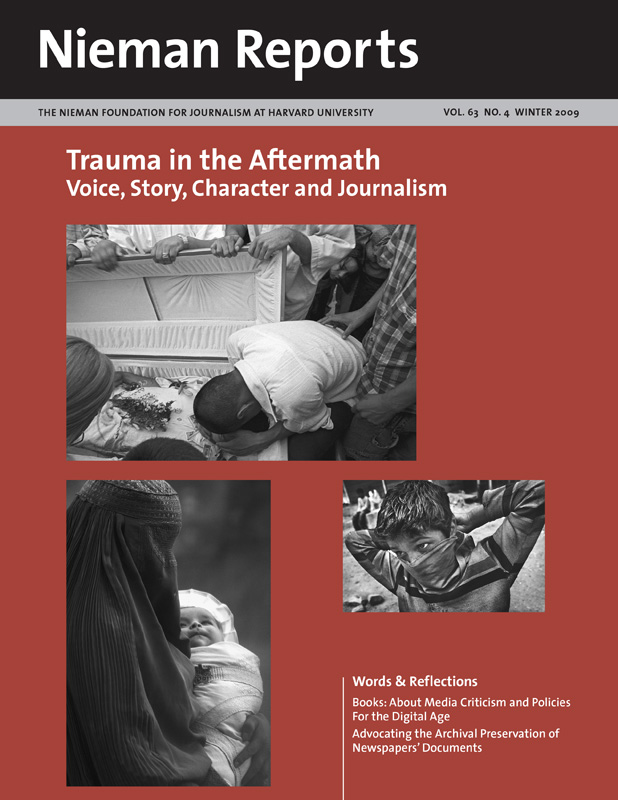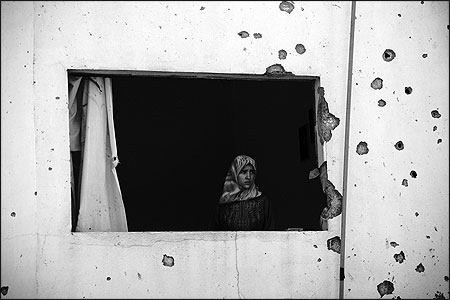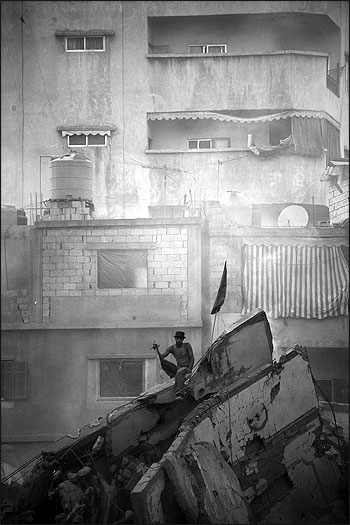
Trauma in the Aftermath
Reporting in the aftermath of tragedy and violence, journalists discover what happens when people survive crippling moments of horror. Pushing past what is formulaic and numbing, they find ways to craft stories where the touch is raw and real. In this issue of Nieman Reports, journalists are joined by trauma researchers and survivors themselves in telling their stories in their own voices. We invite you to listen in.

Scheherezade Faramarzi is an Associated Press reporter who has covered the major conflicts in the Middle East, Pakistan, Afghanistan and North Africa during the last three decades. Her reporting has focused on revolutions, civil war, suicide bombings, kidnappings, hostage negotiations, guerrilla warfare, and terrorism. A 2009 Nieman Fellow, she has been in Beirut since 2006 covering Hizbullah and Iran’s regional influence. She began by talking about competing narratives.
We have covered the Middle East as it has evolved dramatically over the past 30 years that I have been a reporter, gradually in the beginning but at a greater speed in the past decade, especially after 9/11. Nowhere has the transformation been as marked as in the demonization or dehumanization of Middle Eastern people in reporting their suffering and the injustices inflicted on them. In 1982, journalists could walk into a Palestinian refugee camp in Beirut in the aftermath of a massacre and talk to survivors, do our own investigation and write pretty much what we saw and heard. The story would reflect what really happened. This would not be as easy to do today.
Now stories tend to lean more to what authorities want us to believe, and this results, at best, in dismissing deaths of Arabs as collateral damage. Whether on TV or in print, civilians, including children, have taken on a different role in the conflict. When many children were killed in the southern Lebanese town of Qana as they took refuge in a shelter during the 2006 war, much of the Western media accepted Israeli claims at face value and blamed their deaths on Hizbullah for using them as human shields, never checking if this was actually the case. This proved to be wrong, as documented a year later in a report by Human Rights Watch.
In May 2004 U.S. warplanes bombed a house in the Iraqi desert near the Syrian border. The U.S. military immediately said the target was a suspected safe house for foreign fighters from Syria. The Iraqis said the planes attacked a wedding party killing up to 45 people, mostly women and children. The U.S. military denied that women and children were killed. Over the next few days, we were able to gather evidence, including film footage, from the wedding as well as interviews with survivors that indicated the attack was on a wedding party and the victims were overwhelmingly women and children. The U.S. military eventually admitted that it might have been an attack on a wedding, but still insisted that foreign fighters were killed. At one point a spokesman made the remarkable claim that “Bad guys also have weddings.”
In the end, the news media largely abandoned the story and consequently the army got off the hook even though two-year-old Khoolood was no fighter. She survived with severe injuries, but lost her parents and four sisters and brothers in the raid.
Faramarzi tells what happened to other civilians who were attending that wedding and survived the bombing attack.
The deliberate or unconscious dehumanization of Arabs is also reflected in the way they are portrayed on television. We’re all too familiar with images of angry Arab women, thick black cloth wrapped around their tattooed faces, cursing, crying, wailing, beating their heads when innocent loved ones are killed, massacred. These menacing narrow images, dripping with negative energy, do not provoke sympathy in the Western public.
In contrast we see well-dressed poised mourners grieving the deaths of American soldiers or Israelis. Relatives hold onto one another. The whole ceremony is performed with utmost dignity. In between the chanting and eulogies there is utter silence interspersed by quiet weeping while in Gaza cameras show a wide shot of crowds running in a frenzy through the streets carrying high the wobbling exposed body of the deceased. And they zoom in on wailing mourners shouting revenge, eyes flaming with hatred. These selective images confirm the stereotype that Arabs are inherently violent. And viewers become partial to the trauma of one, but far less of the other.
When American soldiers kill two innocent young Iraqis by mistake not only do they not admit their mistake, apologize or pay compensation, but they go so far as to accuse them of being terrorists. Reporters duly put that in the story without question, sometimes even when they know it’s not the case. Why? It’s the balance factor. Already we have planted suspicion in the reader’s mind: maybe they weren’t so innocent after all. Again we dehumanize them. We move away from the real story: the murder of two innocent Iraqi youths. They’re no longer seen as victims, but perpetrators and their deaths perhaps unavoidable. It’s the good guys/bad guys characterization. It’s us and them.
People are so used to the carnage of the Middle East that they have stopped caring. Yet the Middle East has provided Western reporters with the best opportunities to make it big in the industry. Many with stints there, especially in Iraq, return with big promotions and go on to win awards or to write books. But how much do some of these reporters really care about the story or understand the complexity of the region when many don’t even speak its language? How can they understand the suffering of a mother who wants to tell them how the death of her son has destroyed her? Or understand the trauma of a child who witnessed the killing of her father and siblings at a Baghdad intersection by American soldiers? Can a translator really do justice?
There’s supposed to be a connection between the reporter and the subject. That connection is the magic of being a journalist.
I want to share with you my first experience of what to me was a Western reporter’s insensitivity with regard to Arabs. It was in late 1980. An Israeli air strike on a small town south of Beirut had killed scores of civilians including, as always, many children. Their mutilated bodies were scattered in the rubble. “Great story,” this journalist said when he returned from the site and quickly went to type his story.
Two and a half decades later on a quiet morning in Baghdad I ran into a fellow journalist and asked him why he was so frazzled. “There’s no story to write,” he complained. I joked that he shouldn’t worry for there was bound to be a bomb soon. When a bomb did explode somewhere in Baghdad, I told the same journalist that he should be happy now since he’d gotten his story. He didn’t detect the sarcasm in my voice. “Yeah, but no one died,” he grumbled. No death meant no front page.
TV screens don’t show the real horrors of war that we journalists witness, at least not so much in Iraq anymore because since 2004 Western reporters hardly ever leave their offices. What we see is sanitized. Viewers are spared gruesome pictures; they don’t see what’s really going on in Iraq or in Gaza or in Lebanon. If the American people were able to see those pictures, I think they’d have a different view of the war.
Nor are they told in stories from Iraq, which they should be, that somewhere between 250,000 and one million Iraqis have been killed since the start of the conflict. We hear mainly about dead American soldiers. We are told their names, even their children’s names and how they lived their lives before they volunteered to fight in Iraq. The Iraqi dead—no volunteers for the war—are hardly ever mentioned. Americans have no idea of the extent of civilian suffering in Iraq even though it’s their country’s war that caused the deaths.
When I was invited to speak at this conference we had to struggle to find a suitable topic for me. Being a Middle Easterner who grew up in Iran, Iraq and Lebanon, trauma is a fact of life. We don’t even think about it. I faced the horrors of living under an authoritarian regime in Iran, through several Iraqi coups, and then during the Lebanese civil war, just as others there did. It’s our life. I’m not a foreign journalist. I’m not a foreign correspondent.
But what struck me since I’ve been here as a Nieman Fellow is how the Middle East is a topic of endless roundtable discussions and talks, usually by Westerners. I don’t know why but I find boasting about having been in Iraq troubling, even painful, and somewhat arrogant, especially when they pat each other on the back. There’s a kind of glorification of war. I just find no glory in covering sufferings.



In the discussion that followed, Bruce Shapiro, executive director of the Dart Center for Journalism and Trauma, began by asking Faramarzi this question:
"If you were writing your own stories in Iraq now, what are some of the guidelines you would draw out? How would you calibrate your nose for news to represent people more accurately in their suffering?
Faramarzi: I think what I would do—and I have tried to do—is spend much more time than just to get a quote or two. If we’re doing a very in-depth story, I spend hours and hours. But in Iraq for instance, there are no therapists. So they use us. I sometimes feel I’m a therapist. If people know I’m staying in a town in Iraq for several months, people get to know me and come and want to talk. They tell me their problems. I really insist on the fact that you really have to be there not to just be over them. This is what I resent, maybe because I’m a Middle Easterner myself. I appreciate very much what Westerners come and do. They do great stuff, most of them do; but I feel sometimes there’s this kind of “we’re the whites and we’re telling your story, and you should be grateful.”
I remember the first day I arrived in Iraq, a Canadian TV journalist was so angry because they had given his room to me. He was screaming at the hotel staff that “You should be grateful we’re here to cover your story.” He went on and on. He was a sort of celebrity journalist in Canada. I think this is very common. Even if they don’t know it, there is this unconscious thing that we are here to tell your story. This is our country. This is our part of the world. You can’t just become famous because people are dying.
RELATED ARTICLE
North discusses his own reporting in the article "Narratives—With Trauma at Their Core" from this issue.Scott North (Projects reporter, The Daily Herald, Everett, Washington): What you said, Scheherezade, about this being a story that is affecting people where they live and viewing it as a story of who you are, really, people sort of appropriating that, that is one of the key things we have to do as journalists: Recognize that we’re part of that story and we have an effect on others just by coming to tell the story. It’s a real challenge to do it in a way that’s respectful. It’s not about us, even though in a weird way it kind of is.
Shapiro: In the history of journalism there have been storytelling conventions at different times and different places. Sometimes the presence of the journalist—the first-person account—has been more honored as a part of storytelling. At other times, in the U.S. for the last 50 years or so, the first person barely has existed in daily journalism. The Internet is actually bringing the first person back as a forum. It’s a first-person friendly forum, and we’re seeing more first-person reporting in general bleeding into papers. I think the question is not just about the representation of the self of the journalist, but this very deep question of how do we defeat the stereotype.
RELATED ARTICLE
Grinker's words and photographs are in the article "When War Ends: The Trauma That Remains" from this issue.Lori Grinker (Photojournalist): I was embedded for People magazine on the American hospital ship for the first month of the war. My assignment, and the writer’s, was to find an American doctor or medic on the ship and follow them treating American wounded. What started happening was all these Iraqi wounded were coming onto the ship and they didn’t know how to deal with it. They wouldn’t do any stories on it at all. I was on the ship for three weeks and there was not one story about the Iraqis. In America, if it doesn’t relate to us we don’t want to read about it, we don’t want to know about it. I’ve been doing stories about Iraqi refugees. Nobody cares because it’s not about them. They care about the Americans because then, suddenly, they relate to the story.
Kael Alford (Photojournalist): I appreciate so much Scheherezade’s anger at this issue. So many of us who work in Iraq come away feeling angry. We’re covering stories where we feel that the things we’re seeing aren’t represented in the media in the way we perceive them through whatever filters there are out there, whatever choices that are made over which we don’t have control. One of the things that is so important—and I see a small shift—is that reporters who are covering the story need to be local reporters: not only us going there to tell the story, but locals as much as possible. I think this is a really huge problem. It’s ridiculous because we get there and we trust them with our lives, but we don’t trust them to tell the story.
RELATED ARTICLE
Alford's words and photographs are in the article "Telling Untold Stories of What Happened in Iraq" from this issue.In my experience showing photographs of dead Iraqis, particularly at the beginning in 2003 when the war coverage wasn’t about civilian casualties, I tried to publish pictures of civilian casualties during the first two years of the war. [Her photo essay from Iraq begins on page 78.] I still travel with these pictures around the country. I meet groups of Americans all over the country, in small towns, and they’re shocked when they see violent pictures of Iraq because they say they haven’t seen it before, which I know isn’t true. Their pictures are all over the place. They’re on the Web. That’s why I think pictures of violence are important because people don’t believe it’s true until they’re confronted with them in a large group and they’re asked to focus on them.


